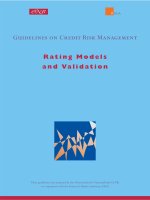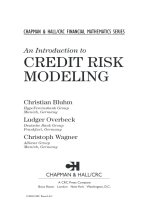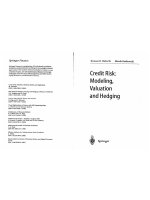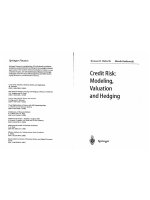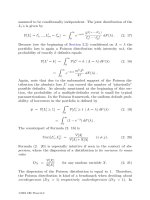Credit risk modeling using excel and VBA (the wiley finance series)
Bạn đang xem bản rút gọn của tài liệu. Xem và tải ngay bản đầy đủ của tài liệu tại đây (18.54 MB, 278 trang )
Credit risk modeling
using Excel and VBA
Gunter Löffler
Peter N. Posch
Credit risk modeling
using Excel and VBA
For other titles in the Wiley Finance series
please see www.wiley.com/finance
Credit risk modeling
using Excel and VBA
Gunter Löffler
Peter N. Posch
Copyright © 2007
John Wiley & Sons Ltd, The Atrium, Southern Gate, Chichester,
West Sussex PO19 8SQ, England
Telephone
+44 1243 779777
Email (for orders and customer service enquiries):
Visit our Home Page on www.wiley.com
All Rights Reserved. No part of this publication may be reproduced, stored in a retrieval system or transmitted in
any form or by any means, electronic, mechanical, photocopying, recording, scanning or otherwise, except under
the terms of the Copyright, Designs and Patents Act 1988 or under the terms of a licence issued by the Copyright
Licensing Agency Ltd, 90 Tottenham Court Road, London W1T 4LP, UK, without the permission in writing of
the Publisher. Requests to the Publisher should be addressed to the Permissions Department, John Wiley & Sons
Ltd, The Atrium, Southern Gate, Chichester, West Sussex PO19 8SQ, England, or emailed to
, or faxed to (+44) 1243 770620.
Designations used by companies to distinguish their products are often claimed as trademarks. All brand names
and product names used in this book are trade names, service marks, trademarks or registered trademarks of their
respective owners. The Publisher is not associated with any product or vendor mentioned in this book.
This publication is designed to provide accurate and authoritative information in regard to the subject matter
covered. It is sold on the understanding that the Publisher is not engaged in rendering professional services.
If professional advice or other expert assistance is required, the services of a competent professional should be
sought.
Other Wiley Editorial Offices
John Wiley & Sons Inc., 111 River Street, Hoboken, NJ 07030, USA
Jossey-Bass, 989 Market Street, San Francisco, CA 94103-1741, USA
Wiley-VCH Verlag GmbH, Boschstr. 12, D-69469 Weinheim, Germany
John Wiley & Sons Australia Ltd, 42 McDougall Street, Milton, Queensland 4064, Australia
John Wiley & Sons (Asia) Pte Ltd, 2 Clementi Loop #02-01, Jin Xing Distripark, Singapore 129809
John Wiley & Sons Canada Ltd, 6045 Freemont Blvd, Mississauga, ONT, L5R 4J3, Canada
Wiley also publishes its books in a variety of electronic formats. Some content that appears in print may not be
available in electronic books.
Anniversary Logo Design: Richard J. Pacifico
Library of Congress Cataloging in Publication Data
Löffler, Gunter.
Credit risk modeling using Excel and VBA / Gunter Löffler, Peter N. Posch.
p. cm.
Includes bibliographical references and index.
ISBN 978-0-470-03157-5 (cloth : alk. paper)
1. Credit—Management 2. Risk Management 3. Microsoft Excel (Computer file)
4. Microsoft Visual Basic for applications. I. Posch, Peter N. II. Title.
HG3751.L64 2007
332.70285 554—dc22
2007002347
British Library Cataloguing in Publication Data
A catalogue record for this book is available from the British Library
ISBN 978-0-470-03157-5 (HB)
Typeset in 10/12pt Times by Integra Software Services Pvt. Ltd, Pondicherry, India
Printed and bound in Great Britain by Antony Rowe Ltd, Chippenham, Wiltshire
This book is printed on acid-free paper responsibly manufactured from sustainable forestry
in which at least two trees are planted for each one used for paper production.
Mundus est is qui constat ex caelo, et terra et mare cunctisque sideribus.
Isidoro de Sevilla
Contents
Preface
Some Hints for Troubleshooting
xi
xiii
1
Estimating Credit Scores with Logit
Linking scores, default probabilities and observed default behavior
Estimating logit coefficients in Excel
Computing statistics after model estimation
Interpreting regression statistics
Prediction and scenario analysis
Treating outliers in input variables
Choosing the functional relationship between the score and explanatory variables
Concluding remarks
Notes and literature
Appendix
1
1
4
8
10
13
15
19
23
24
24
2
The Structural Approach to Default Prediction and Valuation
Default and valuation in a structural model
Implementing the Merton model with a one-year horizon
The iterative approach
A solution using equity values and equity volatilities
Implementing the Merton model with a T -year horizon
Credit spreads
Notes and literature
27
27
30
30
34
39
44
44
3
Transition Matrices
Cohort approach
Multi-period transitions
Hazard rate approach
Obtaining a generator matrix from a given transition matrix
Confidence intervals with the Binomial distribution
Bootstrapped confidence intervals for the hazard approach
Notes and literature
Appendix
45
46
51
53
58
59
63
67
67
viii
Contents
4
Prediction of Default and Transition Rates
Candidate variables for prediction
Predicting investment-grade default rates with linear regression
Predicting investment-grade default rates with Poisson regression
Backtesting the prediction models
Predicting transition matrices
Adjusting transition matrices
Representing transition matrices with a single parameter
Shifting the transition matrix
Backtesting the transition forecasts
Scope of application
Notes and literature
Appendix
5
Modeling and Estimating Default Correlations with the Asset Value
Approach
Default correlation, joint default probabilities and the asset value approach
Calibrating the asset value approach to default experience: the method of
moments
Estimating asset correlation with maximum likelihood
Exploring the reliability of estimators with a Monte Carlo study
Concluding remarks
Notes and literature
73
73
75
78
83
87
88
89
91
96
98
98
99
103
103
105
108
114
117
117
6
Measuring Credit Portfolio Risk with the Asset Value Approach
A default mode model implemented in the spreadsheet
VBA implementation of a default-mode model
Importance sampling
Quasi Monte Carlo
Assessing simulation error
Exploiting portfolio structure in the VBA program
Extensions
First extension: Multi-factor model
Second extension: t-distributed asset values
Third extension: Random LGDs
Fourth extension: Other risk measures
Fifth extension: Multi-state modeling
Notes and literature
119
119
122
126
130
132
135
137
137
138
139
143
144
146
7
Validation of Rating Systems
Cumulative accuracy profile and accuracy ratios
Receiver operating characteristic (ROC)
Bootstrapping confidence intervals for the accuracy ratio
Interpreting CAPs and ROCs
Brier Score
Testing the calibration of rating-specific default probabilities
147
148
151
153
155
156
157
Contents
Validation strategies
Notes and literature
ix
161
162
8
Validation of Credit Portfolio Models
Testing distributions with the Berkowitz test
Example implementation of the Berkowitz test
Representing the loss distribution
Simulating the critical chi-squared value
Testing modeling details: Berkowitz on subportfolios
Assessing power
Scope and limits of the test
Notes and literature
163
163
166
167
169
171
175
176
177
9
Risk-Neutral Default Probabilities and Credit Default Swaps
Describing the term structure of default: PDs cumulative, marginal, and seen
from today
From bond prices to risk-neutral default probabilities
Concepts and formulae
Implementation
Pricing a CDS
Refining the PD estimation
Notes and literature
179
10
Risk Analysis of Structured Credit: CDOs and First-to-Default Swaps
Estimating CDO risk with Monte Carlo simulation
The large homogeneous portfolio (LHP) approximation
Systematic risk of CDO tranches
Default times for first-to-default swaps
Notes and literature
Appendix
197
197
201
203
205
209
209
11
Basel II and Internal Ratings
Calculating capital requirements in the Internal Ratings-Based (IRB) approach
Assessing a given grading structure
Towards an optimal grading structure
Notes and literature
211
211
214
220
223
180
181
181
184
191
193
196
Appendix A1
Visual Basics for Applications (VBA)
225
Appendix A2
Solver
233
Appendix A3
Maximum Likelihood Estimation and Newton’s Method
239
Appendix A4
Testing and Goodness of Fit
245
Appendix A5
User-Defined Functions
251
Index
257
Preface
This book is an introduction to modern credit risk methodology as well a cookbook for
putting credit risk models to work. We hope that the two purposes go together well. From
our own experience, analytical methods are best understood by implementing them.
Credit risk literature broadly falls into two separate camps: risk measurement and pricing.
We belong to the risk measurement camp. Chapters on default probability estimation and
credit portfolio risk dominate chapters on pricing and credit derivatives. Our coverage of
risk measurement issues is also somewhat selective. We thought it better to be selective than
to include more topics with less detail, hoping that the presented material serves as a good
preparation for tackling other problems not covered in the book.
We have chosen Excel as our primary tool because it is a universal and very flexible tool
that offers elegant solutions to many problems. Even Excel freaks may admit that it is not
their first choice for some problems. But even then, it is nonetheless great for demonstrating
how to put models at work, given that implementation strategies are mostly transferable to
other programming environments. While we tried to provide efficient and general solutions,
this was not our single overriding goal. With the dual purpose of our book in mind, we
sometimes favored a solution that appeared more simple to grasp.
Readers surely benefit from some prior Excel literacy, e.g. knowing how to use a simple function such as AVERAGE(), being aware of the difference between SUM(A1:A10)
SUM($A1:$A10) and so forth. For less experienced readers, there is an Excel for beginners
video on the DVD, and an introduction to VBA in the appendix; the other videos supplied
on the DVD should also be very useful as they provide a step-by-step guide more detailed
than the explanations in the main text.
We also assume that the reader is somehow familiar with concepts from elementary
statistics (e.g. probability distributions) and financial economics (e.g. discounting, options).
Nevertheless, we explain basic concepts when we think that at least some readers might
benefit from it. For example, we include appendices on maximum likelihood estimation or
regressions.
We are very grateful to colleagues, friends and students who gave feedback on the
manuscript: Oliver Blümke, Jürgen Bohrmann, André Güttler, Florian Kramer, Michael
Kunisch, Clemens Prestele, Peter Raupach, Daniel Smith (who also did the narration of the
videos with great dedication) and Thomas Verchow. An anonymous reviewer also provided
a lot of helpful comments. We thank Eva Nacca for formatting work and typing video text.
Finally, we thank our editors Caitlin Cornish, Emily Pears and Vivienne Wickham.
xii
Preface
Any errors and unintentional deviations from best practice remain our own responsibility.
We welcome your comments and suggestions: just send an email to or visit our homepage at www.loeffler-posch.com.
We owe a lot to our families. Before struggling to find the right words to express our
gratitude we rather stop and give our families what they missed most, our time.
Some Hints for Troubleshooting
We hope that you do not encounter problems when working with the spreadsheets, macros
and functions developed in this book. If you do, you may want to consider the following
possible reasons for trouble:
• We repeatedly use the Excel Solver. This may cause problems if the Solver add-in is
not activated in Excel and VBA. How this can be done is described in Appendix A2.
Apparently, differences in Excel versions can also lead to situations in which a macro
calling the Solver does not run even though the reference to the Solver is set.
• In Chapter 10, we use functions from the AnalysisToolpak add-in. Again, this has to be
activated. See Chapter 9 for details.
• Some Excel 2003 functions (e.g. BINOMDIST or CRITBINOM) have been changed
relative to earlier Excel versions. We’ve tested our programs on Excel 2003. If you’re
using an older Excel version, these functions might return error values in some cases.
• All functions have been tested for the demonstrated purpose only. We have not strived to
make them so general that they work for most purposes one can think of. For example,
– some functions assume that the data is sorted in some way, or arranged in columns
rather than in rows;
– some functions assume that the argument is a range, not an array. See the Appendix A1
for detailed instructions on troubleshooting this issue.
A comprehensive list of all functions (Excel’s and user-defined) together with full syntax
and a short description can be found at the end of Appendix A5.
1
Estimating Credit Scores with Logit
Typically, several factors can affect a borrower’s default probability. In the retail segment,
one would consider salary, occupation, age and other characteristics of the loan applicant;
when dealing with corporate clients, one would examine the firm’s leverage, profitability or
cash flows, to name but a few. A scoring model specifies how to combine the different pieces
of information in order to get an accurate assessment of default probability, thus serving to
automate and standardize the evaluation of default risk within a financial institution.
In this chapter, we will show how to specify a scoring model using a statistical technique
called logistic regression or simply logit. Essentially, this amounts to coding information into
a specific value (e.g. measuring leverage as debt/assets) and then finding the combination
of factors that does the best job in explaining historical default behavior.
After clarifying the link between scores and default probability, we show how to estimate
and interpret a logit model. We then discuss important issues that arise in practical applications, namely the treatment of outliers and the choice of functional relationship between
variables and default.
An important step in building and running a successful scoring model is its validation.
Since validation techniques are applied not just to scoring models but also to agency ratings
and other measures of default risk, they are described separately in Chapter 7.
LINKING SCORES, DEFAULT PROBABILITIES AND OBSERVED
DEFAULT BEHAVIOR
A score summarizes the information contained in factors that affect default probability.
Standard scoring models take the most straightforward approach by linearly combining those
factors. Let x denote the factors (their number is K) and b the weights (or coefficients)
attached to them; we can represent the score that we get in scoring instance i as:
Scorei = b1 xi1 + b2 xi2 +
+ bK xiK
(1.1)
It is convenient to have a shortcut for this expression. Collecting the b’s and the x’s in
column vectors b and x we can rewrite (1.1) to:
⎡ ⎤
⎡ ⎤
b1
xi1
⎢ b2 ⎥
⎢ xi2 ⎥
⎢ ⎥
⎢ ⎥
Scorei = b1 xi1 + b2 xi2 +
(1.2)
+ bK xiK = b xi
xi = ⎢ ⎥ b = ⎢ ⎥
⎣ ⎦
⎣ ⎦
xiK
bK
If the model is to include a constant b1 , we set xi1 = 1 for each i.
Assume, for simplicity, that we have already agreed on the choice of the factors x – what
is then left to determine is the weight vector b. Usually, it is estimated on the basis of the
2
Estimating Credit Scores with Logit
Table 1.1 Factor values and default behavior
Scoring
instance i
Firm
Year
Default indicator
for year +1
Factor values from the end of
year
yi
xi1
xi2
xiK
1
2
3
4
XAX
YOX
TUR
BOK
2001
2001
2001
2001
0
0
0
1
0.12
0.15
−0 10
0.16
0.35
0.51
0.63
0.21
0.14
0.04
0.06
0.12
912
913
914
XAX
YOX
TUR
2002
2002
2002
0
0
1
−0 01
0.15
0.08
0.02
0.54
0.64
0.09
0.08
0.04
N
VRA
2005
0
0.04
0.76
0.03
observed default behavior.1 Imagine that we have collected annual data on firms with factor
values and default behavior. We show such a data set in Table 1.1.2
Note that the same firm can show up more than once if there is information on this firm
for several years. Upon defaulting, firms often stay in default for several years; in such
cases, we would not use the observations following the year in which default occurred. If a
firm moves out of default, we would again include it in the data set.
The default information is stored in the variable yi . It takes the value 1 if the firm
defaulted in the year following the one for which we have collected the factor values, and
zero otherwise. The overall number of observations is denoted by N .
The scoring model should predict a high default probability for those observations that
defaulted and a low default probability for those that did not. In order to choose the
appropriate weights b, we first need to link scores to default probabilities. This can be done
by representing default probabilities as a function F of scores:
Prob Defaulti = F Scorei
(1.3)
Like default probabilities, the function F should be constrained to the interval from 0 to 1;
it should also yield a default probability for each possible score. The requirements can be
fulfilled by a cumulative probability distribution function. A distribution often considered
for this purpose is the logistic distribution. The logistic distribution function z is defined
as z = exp z / 1 + exp z . Applied to (1.3) we get:
Prob Default i =
Scorei =
exp b xi
1
=
1 + exp b xi
1 + exp −b xi
(1.4)
Models that link information to probabilities using the logistic distribution function are called
logit models.
1
In qualitative scoring models, however, experts determine the weights.
Data used for scoring are usually on an annual basis, but one can also choose other frequencies for data collection as well as
other horizons for the default horizon.
2
Credit Risk Modeling using Excel and VBA
3
In Table 1.2, we list the default probabilities associated with some score values and
illustrate the relationship with a graph. As can be seen, higher scores correspond to a higher
default probability. In many financial institutions, credit scores have the opposite property:
they are higher for borrowers with a lower credit risk. In addition, they are often constrained
to some set interval, e.g. 0 to 100. Preferences for such characteristics can easily be met. If
we use (1.4) to define a scoring system with scores from −9 to 1, but want to work with
scores from 0 to 100 instead (100 being the best), we could transform the original score to
myscore = −10 × score + 10.
Table 1.2 Scores and default probabilities in the logit model
Having collected the factors x and chosen the distribution function F , a natural way
of estimating the weights b is the maximum likelihood method (ML). According to the
ML principle, the weights are chosen such that the probability (=likelihood) of observing
the given default behavior is maximized. (See Appendix A3 for further details on ML
estimation.)
The first step in maximum likelihood estimation is to set up the likelihood function. For
a borrower that defaulted (Yi = 1), the likelihood of observing this is
Prob Defaulti =
(1.5)
b xi
For a borrower that did not default (Yi = 0), we get the likelihood
Prob No defaulti = 1 −
b xi
(1.6)
Using a little trick, we can combine the two formulae into one that automatically gives
the correct likelihood, be it a defaulter or not. Since any number raised to the power of 0
evaluates to 1, the likelihood for observation i can be written as:
Li =
b xi
yi
1−
b xi
1−yi
(1.7)
4
Estimating Credit Scores with Logit
Assuming that defaults are independent, the likelihood of a set of observations is just the
product of the individual likelihoods3 :
N
N
Li =
L=
b xi
yi
1−
b xi
1−yi
(1.8)
i=1
i=1
For the purpose of maximization, it is more convenient to examine ln L, the logarithm of
the likelihood:
N
ln L =
yi ln
b xi
+ 1 − yi ln 1 −
b xi
(1.9)
i=1
This can be maximized by setting its first derivative with respect to b to 0. This derivative
(like b, it is a vector) is given by:
N
ln L
yi −
=
b
i=1
b x i xi
(1.10)
Newton’s method (see Appendix A3) does a very good job in solving equation (1.10) with
respect to b. To apply this method, we also need the second derivative, which we obtain as:
N
ln L
=−
b b
i=1
2
b xi 1 −
b x i xi x i
(1.11)
ESTIMATING LOGIT COEFFICIENTS IN EXCEL
Since Excel does not contain a function for estimating logit models, we sketch how to construct a user-defined function that performs the task. Our complete function is called LOGIT.
The syntax of the LOGIT command is equivalent to the LINEST command: LOGIT(y, x,
[const],[statistics]), where [] denotes an optional argument.
The first argument specifies the range of the dependent variable, which in our case is the
default indicator y; the second parameter specifies the range of the explanatory variable(s).
The third and fourth parameters are logical values for the inclusion of a constant (1 or
omitted if a constant is included, 0 otherwise) and the calculation of regression statistics
(1 if statistics are to be computed, 0 or omitted otherwise). The function returns an array,
therefore, it has to be executed on a range of cells and entered by [Ctrl]+[Shift]+[Enter].
Before delving into the code, let us look at how the function works on an example data
set.4 We have collected default information and five variables for default prediction: Working
Capital (WC), Retained Earnings (RE), Earnings before interest and taxes (EBIT) and Sales
(S), each divided by Total Assets (TA); and Market Value of Equity (ME) divided by Total
Liabilities (TL). Except for the market value, all of these items are found in the balance
sheet and income statement of the company. The market value is given by the number of
shares outstanding multiplied by the stock price. The five ratios are those from the widely
3
Given that there are years in which default rates are high, and others in which they are low, one may wonder whether the
independence assumption is appropriate. It will be if the factors that we input into the score capture fluctuations in average default
risk. In many applications, this is a reasonable assumption.
4
The data is hypothetical, but mirrors the structure of data for listed US corporates.
Credit Risk Modeling using Excel and VBA
5
known Z-score developed by Altman (1968). WC/TA captures the short-term liquidity of
a firm, RE/TA and EBIT/TA measure historic and current profitability, respectively. S/TA
further proxies for the competitive situation of the company and ME/TL is a market-based
measure of leverage.
Of course, one could consider other variables as well; to mention only a few, these
could be: cash flows over debt service, sales or total assets (as a proxy for size), earnings
volatility, stock price volatility. Also, there are often several ways of capturing one underlying
factor. Current profits, for instance, can be measured using EBIT, EBITDA (=EBIT plus
depreciation and amortization) or net income.
In Table 1.3, the data is assembled in columns A to H. Firm ID and year are not required
for estimation. The LOGIT function is applied to range J2:O2. The default variable which
the LOGIT function uses is in the range C2:C4001, while the factors x are in the range
D2:H4001. Note that (unlike in Excel’s LINEST function) coefficients are returned in the
same order as the variables are entered; the constant (if included) appears as the leftmost
variable. To interpret the sign of the coefficient b, recall that a higher score corresponds to
a higher default probability. The negative sign of the coefficient for EBIT/TA, for example,
means that default probability goes down as profitability increases.
Table 1.3 Application of the LOGIT command to a data set with information on defaults and five
financial ratios
Now let us have a close look at important parts of the LOGIT code. In the first lines of
the function, we analyze the input data to define the data dimensions: the total number of
observations N and the number of explanatory variables (incl. the constant) K. If a constant
is to be included (which should be done routinely) we have to add a vector of 1’s to the
matrix of explanatory variables. This is why we call the read-in factors xraw, and use them
to construct the matrix x we work with in the function by adding a vector of 1’s. For this, we
could use an If-condition, but here we just write a 1 in the first column and then overwrite
it if necessary (i.e. if constant is 0):
Function LOGIT(y As Range, xraw As Range, _
Optional constant As Byte, Optional stats As Byte)
If IsMissing(constant) Then constant = 1
If IsMissing(stats) Then stats = 0
6
Estimating Credit Scores with Logit
’Count variables
Dim i As long, j As long, jj As long
’Read data dimensions
Dim K As Long, N As Long
N = y.Rows.Count
K = xraw.Columns.Count + constant
’Adding a vector of ones to the x matrix if constant=1,
’name xraw=x from now on
Dim x() As Double
ReDim x(1 To N, 1 To K)
For i = 1 To N
x(i, 1) = 1
For j = 1 + constant To K
x(i, j) = xraw(i, j - constant)
Next j
Next i
…
The logical value for the constant and the statistics are read in as variables of type byte,
meaning that they can take integer values between 0 and 255. In the function, we could
therefore check whether the user has indeed input either 0 or 1, and return an error message
if this is not the case. Both variables are optional, if their input is omitted the constant is
set to 1 and the statistics to 0. Similarly, we might want to send other error messages, e.g.
if the dimension of the dependent variable y and the one of the independent variables x do
not match.
In the way we present it, the LOGIT function requires the input data to be organized in
columns, not in rows. For the estimation of scoring models, this will be standard, as the number of observations is typically very large. However, we could modify the function in such a
way that it recognizes the organization of the data. The LOGIT function maximizes the log
likelihood by setting its first derivative to 0, and uses Newton’s method (see Appendix A3)
to solve this problem. Required for this process are: a set of starting values for the unknown
parameter vector b; the first derivative of the log-likelihood (the gradient vector g()) given
in (1.10)); the second derivative (the Hessian matrix H() given in (1.11)). Newton’s method
then leads to the rule:
b1 = b0 −
2
ln L
b0 b 0
−1
ln L
= b0 − H b0
b0
−1
g b0
(1.12)
The logit model has the nice feature that the log-likelihood function is globally concave.
Once we have found the root to the first derivative, we can be sure that we have found the
global maximum of the likelihood function.
A commonly used starting value is to set the constant as if the model contained only a
constant, while the other coefficients are set to 0. With a constant only, the best prediction
of individual default probabilities is the average default rate, which we denote by y¯ ; it can
be computed as the average value of the default indicator variable y. Note that we should
not set the constant b1 equal to y¯ because the predicted default probability with a constant
Credit Risk Modeling using Excel and VBA
7
only is not the constant itself, but rather
b1 . To achieve the desired goal, we have to
apply the inverse of the logistic distribution function:
−1
y¯ = ln y¯ / 1 − y¯
(1.13)
To check that it leads to the desired result, examine the default prediction of a logit model
with just a constant that is set to (1.13):
Prob y = 1 =
b1 =
=
1
1
=
1 + exp −b1
1 + exp − ln y¯ / 1 − y¯
1
= y¯
1 + 1 − y¯ /¯y
(1.14)
When initializing the coefficient vector (denoted by b in the function), we can already
initialize the score b x (denoted by bx), which will be needed later. Since we initially set
each coefficient except the constant to zero, bx equals the constant at this stage. (Recall that
the constant is the first element of the vector b, i.e. on position 1.)
’Initializing the coefficient vector (b) and the score (bx)
Dim b() As Double, bx() As Double, ybar As Double
ReDim b(1 To K): ReDim bx(1 To N)
ybar = Application.WorksheetFunction.Average(y)
If constant = 1 Then b(1) = Log(ybar / (1 − ybar))
For i = 1 To N
bx(i) = b(1)
Next i
If the function was entered with the logical value constant=0, the b(1) will be left zero,
and so will be bx. Now we are ready to start Newton’s method. The iteration is conducted
within a Do While loop. We exit once the change in the log-likelihood from one iteration
to the next does not exceed a certain small value (like 10−11 ). Iterations are indexed by the
variable iter. Focusing on the important steps, once we have declared the arrays dlnl
(gradient), Lambda (prediction b x ), hesse (Hessian matrix) and lnl (log-likelihood)
we compute their values for a given set of coefficients, and therefore for a given score bx.
For your convenience, we summarize the key formulae below the code:
’Compute prediction Lambda, gradient dlnl,
’Hessian hesse, and log likelihood lnl
For i = 1 To N
Lambda(i) = 1 / (1 + Exp(−bx(i)))
For j = 1 To K
dlnL(j) = dlnL(j) + (y(i) − Lambda(i)) * x(i, j)
For jj = 1 To K
hesse(jj, j) = hesse(jj, j) − Lambda(i) * (1 − Lambda(i)) _
* x(i, jj) * x(i, j)
Next jj
Next j
lnL(iter) = lnL(iter) + y(i) * Log(1 / (1 + Exp(−bx(i)))) + (1 − y(i)) _
* Log(1 − 1 / (1 + Exp(−bx(i))))
Next i
8
Estimating Credit Scores with Logit
Lambda =
b xi = 1/ 1 + exp −b xi
N
dlnl =
yi −
b xi x i
i=1
N
hesse = −
b xi 1 −
b x i xi x i
i=1
N
lnl =
yi ln
b xi + 1 − yi ln 1 −
b xi
i=1
There are three loops we have to go through. The function for the gradient, the Hessian and
the likelihood each contain a sum for i=1 to N. We use a loop from i=1 to N to evaluate
those sums. Within this loop, we loop through j=1 to K for each element of the gradient
vector; for the Hessian, we need to loop twice, so there’s a second loop jj=1 to K. Note
that the gradient and the Hessian have to be reset to zero before we redo the calculation in
the next step of the iteration.
With the gradient and the Hessian at hand, we can apply Newton’s rule. We take the
inverse of the Hessian using the worksheetFunction MINVERSE, and multiply it with the
gradient using the worksheetFunction MMULT:
’Compute inverse Hessian (=hinv) and multiply hinv with gradient dlnl
hinv = Application.WorksheetFunction.MInverse(hesse)
hinvg = Application.WorksheetFunction.MMult(dlnL, hinv)
If Abs(change) <= sens Then Exit Do
’ Apply Newton’s scheme for updating coefficients b
For j = 1 To K
b(j) = b(j) − hinvg(j)
Next j
As outlined above, this procedure of updating the coefficient vector b is ended when the
change in the likelihood, abs(ln(iter)-ln(iter-1)), is sufficiently small. We can
then forward b to the output of the function LOGIT.
COMPUTING STATISTICS AFTER MODEL ESTIMATION
In this section, we show how the regression statistics are computed in the LOGIT function. Readers wanting to know more about the statistical background may want to consult
Appendix A4.
To assess whether a variable helps to explain the default event or not, one can examine a
t ratio for the hypothesis that the variable’s coefficient is zero. For the jth coefficient, such
a t ratio is constructed as:
tj = bj /SE bj
(1.15)
where SE is the estimated standard error of the coefficient. We take b from the last iteration
of the Newton scheme and the standard errors of estimated parameters are derived from the
Hessian matrix. Specifically, the variance of the parameter vector is the main diagonal of


